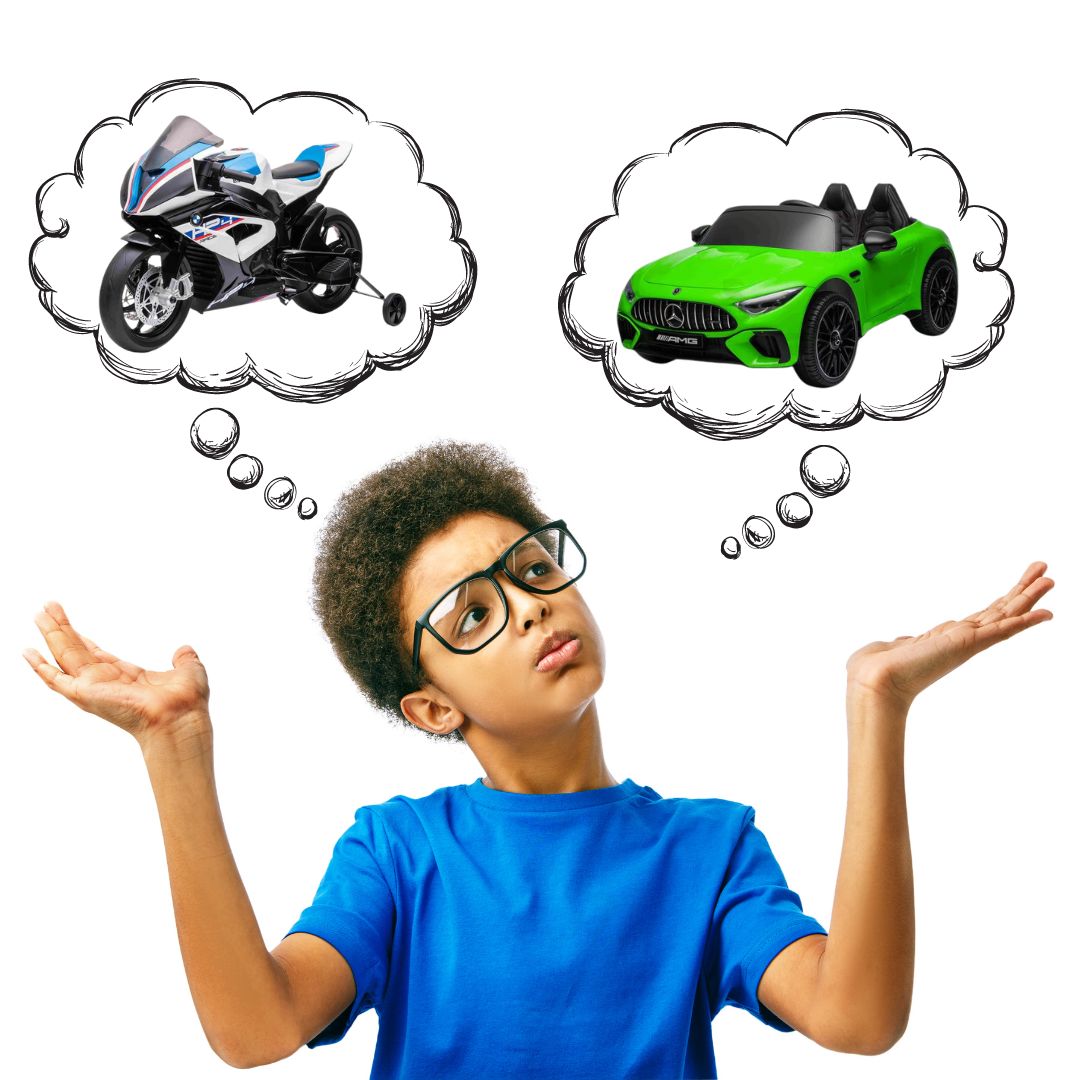
Updated: 28.4.25
Choosing the perfect ride-on toy for your child is more than a fun decision—it's an investment in their independence, motor skills, and pure joy.
But when it comes down to picking between a kids' ride-on car and a motorbike, the choice isn’t always clear.
Beyond the excitement, it’s about finding the right fit for your child's safety, developmental needs, and thirst for adventure. Let’s dive into everything you need to know to make the best choice.
Safety First: What You Need to Know
Age, Safety, and Legal Considerations
Ride-ons are designed for specific age groups to ensure appropriate speeds, controls, and stability. Always check manufacturer guidelines and local laws to make sure your child is ready—and legally allowed—to ride safely.
Protective Gear is a Must
Helmets, knee pads, and elbow pads aren’t just accessories—they’re essentials. Proper protective gear dramatically reduces injury risks and builds a strong foundation for safe habits early on.
Ride-On Car vs. Motorbike: Key Differences
Speed and Control
Cars generally offer greater stability with slower, steadier speeds—perfect for younger children. Motorbikes, on the other hand, offer more agility and excitement, ideal for confident kids ready for a faster-paced challenge.
Terrain and Versatility
Cars are best on smooth, flat surfaces like patios or driveways. Motorbikes handle more diverse terrains, from grassy parks to dirt trails, offering a wider world of adventure.
Accessibility and Customisation Options
Ride-Ons for All Abilities
Accessibility matters. Many ride-on vehicles can be adapted for children with mobility challenges, making sure that everyone can experience the thrill of riding independently.
Make It Theirs
Customising ride-ons—from colour choices and decals to personalised license plates—lets your child express their style and take pride in their very own set of wheels.
Parental Priorities: Safety and Peace of Mind
Recognising Safety Risks
Every ride-on carries some risk. Choosing models with safety features like low-speed settings, seat belts, and parental remote controls (for cars) can ease your concerns and ensure a safer ride.
Understanding Local Rules
Stay informed about where and how ride-on toys can be used legally in your area. Keeping playtime safe and legal means fewer headaches—and more fun!
Ride-On Cars vs. Motorbikes: At a Glance
| Feature | Ride-On Cars | Motorbikes |
|---|---|---|
| Stability & Safety | Higher, ideal for younger kids | Requires balance, better for older kids |
| Skill Development | Steering and pedal coordination | Balance, mental focus, and coordination |
| Physical Activity | Encourages movement and basic exercise | Higher physical demands, fitness building |
| Social Play | Great for group play and sharing | Encourages independence and solo focus |
| Terrain | Best for flat surfaces | Handles grass, dirt, gravel |
| Customisation | Lots of features (music, lights, plates) | More basic; mainly cosmetic customisation |
| Age Suitability | Toddlers to early school age | Older children with better balance |
| Safety Gear | Helmet recommended | Helmet, pads, boots essential |
| Accessibility | Good for mobility needs | Fewer accessibility options |
Which is Right for Your Child?
Ultimately, the choice between a ride-on car and a motorbike depends on your child’s age, abilities, personality, and the type of adventure you envision for them.
- Choose a ride-on car if you want easy stability, social fun, and lots of interactive features.
- Choose a motorbike if your child craves independence, excitement, and a bigger physical challenge.
Both options deliver powerful developmental benefits, and either one can spark a lifelong love for movement, exploration, and fun.
Conclusion
In the end, it's not just about picking a toy—it's about giving your child a ticket to independence, creativity, and growth. Choose with their unique needs in mind, and you’ll be giving them more than just wheels—you’ll be giving them confidence and adventure, wrapped up in pure, unforgettable fun.
Ready to Find Their Perfect Ride? 🚗🏍️
Whether it's the classic charm of a ride-on car or the thrilling adventure of a motorbike, RiiRoo has the perfect set of wheels for your little racer!
Explore our huge collection today and start their next big adventure!
Shop Ride-On CarsShop Ride-On Motorbikes







Share:
What Happens If I Can't Choose Between Different Kid's Ride Ons?
Is It Worth Buying a Kid's Drift Go Kart?